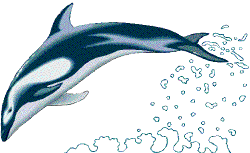

Goals:
1. Students will become familiar with Gray's Reef National Marine Sanctuary.
2. Students will learn how to classify marine mammals.
Resources:
1. Mammal activity based on: http://www.graysreef.nos.noaa.gov
2. Off shore to Gray's Reef National Marine Sanctuary web site at:
http://www.graysreef.nos.noaa.gov
Time: This lesson will take approximately 3 hours to complete. Steps one and two will take 1.5 hours and step three will take about 1.5 hours.
Materials:
Magazines
Paper
Glue or Tape
Scissors
Teacher Background:
Marine Study- Saltwater seas and oceans cover over 70% of the earth's surface. This system of water is a dominant influence on climatic conditions, local weather, including temperatures, rainfall and wind, and general atmospheric circulation. The oceans contain the tallest mountains and the deepest canyons on earth. Life originated in the oceans, and the oceans continue to support more species of plants and animals than all the continents combined.
Gray's Reef National Marine Sanctuary- Congress passed the Marine Protection, Research and Sanctuaries Act in 1972 in response to a growing awareness of the importance of the marine environment to the United States. The Act enabled the United States to designate as National Marine Sanctuaries areas within its boundaries that have significant ecological, historical, aesthetic, or recreational value. Gray's Reef was designated a National Marine Sanctuary in 1981 and is managed by the National Oceanic and Atmospheric Administration (NOAA). It is located 17.5 nautical miles east of Sapelo Island, Georgia Marine Institute on Sapelo in the 1960's. Gray's Reef is not a coral reef such as those found in the tropics. It is a limestone rock outcropping, which stands above the shifting sands of the nearly flat continental shelf. This rocky outcropping provides a solid place for algae and sessile marine invertebrates to attach. the attached organisms provide food and hiding places for other invertebrate animals and fishes. The rich diversity of life around these rocky areas makes it easy to understand why they are often referred to as "live bottoms" Since Gray's Reef is well offshore and lies in 50 to 70 feet of water, most visitors are experienced scuba divers and sport fishermen familiar with offshore waters.
Procedure:
Step 1- Students will make a list of characteristics common to mammals and discuss with in the class this list. Students will divide into small groups and creates lists of all the mammals they can name.
Step 2- Students will work on questions in small groups and then discuss their answers as a class.
1)How are fish similar to whales? How are they different?
2)How are humans similar to whales? How are they different?
Step 3- Students will, in small groups, find pictures in magazines to construct a mammal collage.
Assessment:
Students will each be given a grade on the collage. They will also be given a grade for their level of participation with in the group and overall effort on the mammal list and discussion questions.
4 points= Worked well with the group
3 points= Worked well with the group most of the time
2 points= Worked well with the group some of the time
1 points= Did not work well with the group
4 points= Student contributed to working on the collage at all times
3 points= Student contributed to working on the collage most of the time
2 points= Student contributed to working on the collage some of the time
1 point= Student did not contribute to the collage at all
Curricular Strands and Major Concepts:
Science- Students will understand how to define an animal as a mammal.
Communication Arts- Students will be orally communicating in small groups as well as reading the short story to themselves.
Social Studies- Students will learn locations of Sapelo Island as well as Gray's Reef.
Possible Extensions:
1. Write a compare/contrast essay on mammals and non-mammals.
2. Make another collage with pictures of non-mammals.
3. Find information on the Internet and write letters inquiring about Gray's Reef National Marine Sanctuary.
Back to Table of Contents
Back to Main Page